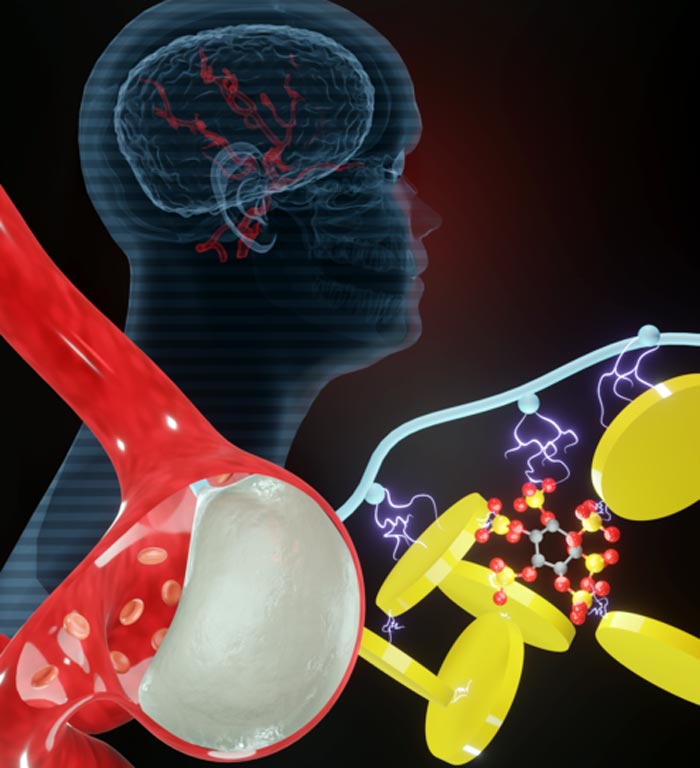Injectable biomaterial

Terasaki Institute for Biomedical Innovation scientists have produced an improved shear-thinning biomaterial for treatment of aneurysms. It exhibits improvements in strength, stress resistance, and injectability, as well as the ability to accelerate blood coagulation at the aneurysm site. Additionally, it decreases the potential for immunotoxic side effects.
Credit: Terasaki Institute for Biomedical Innovation (TIBI)
… with enhanced mechanical and coagulative capabilities for treating aneurysms.
Aneurysms, abnormal enlargement or ballooning in the wall of blood vessels can result in rupture and fatal bleeding. To treat aneurysms, it is essential to stop the blood flow to the affected area and prevent rupture of the vessel. Existing treatments for treating aneurysms include catheter-delivered stainless-steel coils or injectable biomaterials placed at the aneurysm site; however, coils sometimes migrate, necessitating repeat procedures. Furthermore, there are problems with injectable biomaterials currently on the market, such as high cost, leakage, cytotoxic effects, and catheter clogs.
In a recent innovative study, a team of scientists from the Terasaki Institute for Biomedical Innovation (TIBI), developed a new injectable hydrogel for treatment of aneurysms. The new biomaterial was created by adding sodium phytate (Phyt), a rice bran-derived compound, to a gelatin-based compound. This new additive decreased potential immunotoxic side effects and gave the material the ability to accelerate blood coagulation at the aneurysm site. Phyt is biocompatible, biologically active, biodegradeable and already in use for biomedical applications. It has a high concentration of negatively charged phosphate groups that interacts strongly with the gelatin and silicate nanoparticles (SN) in the Gel-SN formulation. This helps to promote even greater cohesion, triggers initiation of the coagulation process, and increases affinity for blood components for faster coagulation.
The scientists also observed that the addition of Phyt reduced the pore size of the new hydrogel, thereby increasing cohesion. The new biomaterial was found to have enhanced shear-thinning properties, minimum swelling when submerged in liquid (important in aneurysm treatment), facilitated injectability, and optimum cellular biocompatibility. The hydrogel was also found to have significantly improved coagulation rates and reduced clotting times. Phyt is known to enhance blood clotting, hence stability in blocking blood flow and prevention of clot migration was particularly improved.
The new injectable hydrogel is a versatile platform, can be delivered via catheters and is expected to find use in various minimally invasive treatments including auto immune diseases as well as cancer.
“We constantly strive to improve and obtain the best possible therapeutic treatments,” said Ali Khademhosseini, Ph.D., TIBI’s Director and CEO. “In doing so, it creates additional tools that we can use in a variety of biomedical applications.”
Authors are: Fatemeh Zehtabi, Hossein Montazerian, Reihaneh Haghniaz, Kaylee Tseng, Neda Mohaghegh, Kalpana Mandal, Behnam Zamanian, Mehmet Remzi Dokmeci, Mohsen Akbari, Alireza Hassani Najafabadi, Han-Jun Kim, and Ali Khademhosseini.
This work was supported by funding from the National Institutes of Health (HL140951).
PRESS CONTACT
Stewart Han, shan@terasaki.org, +1 818-836-4393
Terasaki Institute for Biomedical Innovation
The Terasaki Institute for Biomedical Innovation (terasaki.org) is a non-profit research organization that invents and fosters practical solutions that restore or enhance the health of individuals. Research at the Terasaki Institute leverages scientific advancements that enable an understanding of what makes each person unique, from the macroscale of human tissues down to the microscale of genes, to create technological solutions for some of the most pressing medical problems of our time. We use innovative technology platforms to study human disease on the level of individual patients by incorporating advanced computational and tissue-engineering methods. Findings yielded by these studies are translated by our research teams into tailored diagnostic and therapeutic approaches encompassing personalized materials, cells and implants with unique potential and broad applicability to a variety of diseases, disorders, and injuries.
The Institute is made possible through an endowment from the late Dr. Paul I Terasaki, a pioneer in the field of organ transplant technology.
Journal: Macromolecular Bioscience
DOI: 10.1002/mabi.202200333
Method of Research: Experimental study
Subject of Research: Not applicable
Article Title: Sodium phytate-incorporated gelatin-silicate nanoplatelet composites for enhanced cohesion and hemostatic function of shear-thinning biomaterials
Article Publication Date: 26-Oct-2022
Media Contact
Stewart Han
Terasaki Institute for Biomedical Innovation
shan@terasaki.org
Office: 818-836-4393
All latest news from the category: Medical Engineering
The development of medical equipment, products and technical procedures is characterized by high research and development costs in a variety of fields related to the study of human medicine.
innovations-report provides informative and stimulating reports and articles on topics ranging from imaging processes, cell and tissue techniques, optical techniques, implants, orthopedic aids, clinical and medical office equipment, dialysis systems and x-ray/radiation monitoring devices to endoscopy, ultrasound, surgical techniques, and dental materials.
Newest articles

Largest magnetic anisotropy of a molecule measured at BESSY II
At the Berlin synchrotron radiation source BESSY II, the largest magnetic anisotropy of a single molecule ever measured experimentally has been determined. The larger this anisotropy is, the better a…

Breaking boundaries: Researchers isolate quantum coherence in classical light systems
LSU quantum researchers uncover hidden quantum behaviors within classical light, which could make quantum technologies robust. Understanding the boundary between classical and quantum physics has long been a central question…

MRI-first strategy for prostate cancer detection proves to be safe
Active monitoring is a sufficiently safe option when prostate MRI findings are negative. There are several strategies for the early detection of prostate cancer. The first step is often a…



